Uniform and Equipment Guidelines
The members of IR 75 strive to create the most authentic WW1 experience possible. Our uniform and equipment standards are high. The attitude of “this is good enough” is not acceptable in our unit and is unfair to those of us who have invested considerable time and money in getting our impressions right. We do not require you to purchase from specific vendors, what we require is that the item be correct. In short, we don’t care where you get it as long as it is good. Remember we are doing a late 1918 impression, the use of late-war and ersatz items is encouraged.
Do some research before purchasing items. When in doubt, ask another member. Take a look at the original photos on this page or in reference books to give you an example of what the gear looked like and how it was worn. Again, when in doubt, ASK!
A NOTE ABOUT LEATHER - In September of 1915, the general order to blacken all leather equipment was given out. However, original brown leather items dated after 1915 are commonly found. We emphasize a late 1918 impression and as such, either black or brown gear is acceptable and the mixing and matching of colors is fine. With brown leather, try to darken it as much as possible with Pecard, dubbing, Huberd’s shoe grease, or a 50/50 mix of black and brown polish.. The light brown, brand new, “Vegetable tan” color just screams “I’m a newbie” and should be avoided. Let your gear get weathered and aged, let it have that “lived-in” look. Leaving mud stains on your gear, as an example, is a good way to add to the authentic appearance we strive for in IR 75.
Do NOT use dyed black leather German WW2 gear. In WW1 leather gear was issued brown and then blackened locally. If you want to blacken your leather gear, contact us and we will give you an acceptable "recipe"
CARE OF EQUIPMENT - The German Army was known for it’s frugality and recycling of equipment and uniforms. Uniforms and equipment that were damaged were usually replaced when soldats came off of the line with the damaged item being sent to a depot to be repaired. Should you blow out the knee or elbow of your uniform, pop buttons, etc, repair it at the earliest possible time. Rips and blow-outs can be nicely patched with a piece of field-grey wool. (it doesn’t have to match exactly)
Below are the basic items you will need in order to participate at an event. Before purchasing a major item like a tunic or rifle, make sure you ASK a senior member if it is acceptable or not.
_________________________________________________________
STAHLHELM - This is the most distinctive part of the German soldat's uniform. It is larger than it’s WW2 counterpart and is recognized by it’s distinctive “Frankenstein” lugs on the side. Either the standard M16 or M18 stahlhelm may be worn. The “cut-out” style of stahlhelm is not permitted. It must be complete with proper 3-pad leather liner and correct chinstrap. The chinstrap can be black or brown leather, or ersatz cloth, with either brass or steel hardware. Te only option for our soldaten is to get an original shell and rebuild it. ( do NOT use an original liner or chinstrap in the field!) The helmet must be the proper grey-green color. Camouflage painted helmets are not allowed. There is no evidence to support them being worn by members of IR 75. If you acquire an original camouflage helmet, you may wear it as long as it has a cover over it. Covers should be or either grey or tan cloth and in the correct pattern. REPRO STAHLHELMS ARE NOT ALLOWED!!!
FELDMUTZ - This is a simple pillbox style hat made of feldgrau wool with a white or grey cloth liner. The soldat can have either the early style mutz, with a red band and piping, or the later Einheitsmutz with green band and piping. If wearing the early style with the red band, you must get a grey camoflauge band to cover the red band. Our original IR 75 photos show widespread use of these grey bands. The feldmutz must have both the National (Black/white/red) and Bremen (White/red/white) cockade. The cockades must be the large sewn-on type. When buying a mutz, make sure it is of the proper cut- it should stand straight up or nearly straight up. Avoid the repro style of mutz that flops down on top. . Gefreiters and Unteroffiziers are authorized to wear a private purchase mutz with a leather visor. When you are not wearing it, it should be kept in your breadbag, tornister or inside the front of your tunic, *not* tucked behind your belt!
TUNIC - There are three types of tunics that are allowable in IR 75- the 1910, the 1914 (Transitional) and the 1915 (Bluse). The style of tunic you wear is up to you, but it must be of the correct color and cut and must have all proper buttons, hooks, ramps, liner, etc. There is plenty of photographic evidence to show that the 1910 tunic was worn all the way through the end of the war. However, if wearing the 1910 or transitional tunic, you will need to paint all brass buttons with feldgrau paint.
The 1910 tunic - Made of grey wool, it had red piping down the front, around the collar and cuffs, and rear skirts, and the cuffs was of the “Brandenburg” style. The epaulet buttons should have the company #4 on them. The shoulderstraps should be piped in white, with a red chainstitched “75” and should be of the “slip-on” variety.
The 1914 (transitional) tunic - Introduced in late 1914 to save on material, it differed from the 1910 in that the cuffs were of the “turn-back” style and the rear skirt was plain. The epaulet buttons should have the company #4 on them. The shoulderstraps should be either piped in white or left unpiped, with a red chainstitched “75” and may be of the “slip-on” or “sewn-down” variety.
The 1915 Bluse - Introduced in September of 1915, it was much plainer and more functional than earlier tunics. Made of grey-green wool with a fly-front and a collar covered in pea-green “abzeichen-tuch”, it should have rimmed crown epaulet buttons. The shoulderstraps should be piped in white or left unpiped, with a red chainstitched “75” and are sewn directly to the uniform.
NECK STOCK - Worn around the neck, it prevents the collar from chafing and also provides a “squared away“ appearance to your impression. Acceptable styles are either all white, all grey, or grey on one side and black on the other side. A grey wool scarf is also suitable.
SHIRT - The issue German shirt was collarless and made of heavy white cotton. It was universally hated by the soldiers as being heavy and uncomfortable. Period civilian shirts are also acceptable (such as the collarless union, or “granddad” shirt), as well as a grey wool sweater or a period cotton undershirt (the infamous “wife beater” or a cap sleeve undershirt)
TROUSERS - In IR 75, you are authorized to wear either feld-grau or stein-grau wool trousers. They may be either piped in red or left unpiped (piping was done away with later in the war). They should be of the correct cut, high-waisted and must have the correct half-belt in the back and watch pocket in the front.
FOOTWEAR - You have the choice of wearing the classic leather M1866 Marchsteifel (jackboots) or lace up ankle shoes. If wearing jackboots, they should be the correct WW1 pattern with side seams, rough-out leather and can be either black or brown. Ankle boots should have leather laces and can also be black or brown. Regardless of your choice, your footwear must have leather soles and hobnails. With the ankle shoes, grey wool puttees must also be worn. Leather leggings are not allowed. WW2 German ankle boots are also acceptable. Rubber soles and heels are not permitted, and neither are Bundeswehr or East German jackboots.make sure your boots are well broken in before you wear them to an event, as you will be marching and drilling in them!
BELT WITH BUCKLE - The belt can be either black or brown, and made of rough-out leather. We wear the Prussian “Gott Mit Uns” belt buckle. Either the M95 brass and silver buckle or the M15 steel belt buckle (preferred) may be worn. If wearing the M95 be sure and dull down the shine on it.
AMMUNITION POUCHES - Each soldat must have two 3-pocket ammunition pouches. These must be of the larger WW1 style and hold 3 ammunition clips per pocket. They can be either black or brown, and of smooth or pebble-grain leather. Repro, Turkish or Yugoslavian model 1924 pouches are all just fine.
BAYONET WITH FROG - The 98/05 “butcher” bayonet is the standard bayonet for IR 75. It must be full size and should have it’s correct scabbard of either black-painted or blued steel, or brass and leather. Sawback bayonets are *not* allowed. Some repro bayonets sold by some vendors are incorrect in that the blades and metal parts are blued. If you purchase a repro bayonet you must removing the bluing (soaking it in vinegar usually works). Ersatz bayonets are acceptable provided that they are of a correct pattern. The bayonet frog can be black or brown leather and should have the rough side out. The bayonet knot (troddel) is an optional item worn right up until the end of the war, and it’s use is encouraged in our unit. The colors for the 4th Kompanie are blue on both ends with a white center.
SHOVEL WITH CARRIER - The standard issue shovel is of the “Linnemann” pattern, with a straight wooden handle that ends in a pronounced ball and a flat blade, not a point. WW2 straight handled shovels are just fine, as are Swiss, Finnish, Russian and East German shovels. Folding shovels are not allowed. The carrier should have two belt loops, be of the “open-back” style and can be of either brown or black leather. The retaining strap of the carrier will wrap around the bayonet scabbard to hold the two together.
BREADBAG WITH STRAP - The issue breadbag was made in varying shades of ochre (early war) or grey (after 1915). Unlike the WW2 breadbags, it has only one D-ring and leather loop, this is to hold the canteen in place. The breadbag is good for holding small items like your esbit stove, spork, a can or two of food and a spare pair of socks. The breadbag strap is worn around your neck and clipped to the ammo pouches, yoke style, for added support when not wearing the backpack.
CANTEEN - Either the early screw-top, later cork-top or ersatz glass styles with a wool, ersatz or corduroy cover in varying shades of brown or grey may be worn. WW2 canteens are not acceptable. Either get a repro or use an original that has been cleaned and rebuilt.
GAS MASK/CANISTER - Soldats can wear either the repro “GummiMask” or “LederMask” or an original “LederMask” (not advised). The canister should be painted feldgrau and have proper straps, either cloth or ersatz material, or use a breadbag strap. The early war cloth belt-carrier is prohibited, while they were in use by storm troops up to the end of the war, the average soldat carried the metal canister.
SOLDBUCH - This should be filled out with your persona’s info, in Sutterlein script, and will be stamped with regimental stamps at your first event.
RIFLE - The only acceptable rifle for IR 75 is the Mauser GEW-98. The "Comission" Mauser 88 and the 98a carbine iare not allowed. The rifle must be complete with proper Lange (“roller coaster”) rear sight, cleaning rod, correct leather or ersatz sling and in proper working condition.
__________________________________________________________
SECONDARY ITEMS- These are items that are not required but will nicely round out your impression and provide you with a few comforts in the trenches
OVERCOAT- The Model 1915 overcoat is preferred.. It should have the correct abzeichen tuch collar, and like the tunic it should be correct in cut, color and have all proper hardware. Shoulderstraps are optional, but if worn they should be unpiped. If the early Model 1907 overcoar is worn, it must have red square collar patches. The 1908 "ersatz" overcoat is also allowed, however the buttons must be painted.
TORNISTER- Commonly known as Der Affe (the monkey), the Model 1895 Tornister had a square wooden frame and was covered in canvas. Earlier models had a fur covering. If worn, it should be complete with all correct straps and tent pole bag. Either a repro or original is allowed, as are 1920’s/30’s political packs as long as they are the same style. If getting a pack you should really go all out and finish it with mess kit, zeltbahn and overcoat. Also available is the canvas rucksack in either ochre or grey. These are acceptable at late-war events *only*.
ZELTBAHN- The zeltbahn can be either feldgrau or ochre in color. It should have all buttons intact. While not a required item, it is recommended the soldat have one, as they are very handy to have in the field. If not carried with the tornister they can be either slung across the shoulders, yoke style, wrapped into an assault pack, or worn shoulder to hip, bandolier style and tied with a rope or breadbag strap.
MESSKIT WITH UTENSIL- The messkit of WW1 was taller than the WW2 messkit. Either an original or correct reproduction can be used. It should be complete with bail handle and be either black or field grey in color. The fork/spoon eating utensil is carried inside.
FOOT WRAPS- Squares of grey felt or wool, these are worn “over” your socks and do wonders to keep your feet warm and prevent blisters.
VEST- Grey or grey-green wool and of a period cut, to be worn under the tunic. They are great on cold nights.
LEATHER JERKIN- these were highly prized by troops. Either repro German or British jerkins are allowed. WW2 British jerkins are identical to the WW1 style and are perfect to wear. They are great for warmth and to keep your tunic from getting torn up.
BLANKET- Blankets were of grey wool and were generally quite shabby. There were no issued blankets, the belief was the the overcoat was enough to keep a soldat warm. However it was not uncommon for soldaten to scrounge blankets wherever they could find them. Any solid grey wool blanket will do.
FLASHLIGHT- European “box” style 12v flashlight with a large round “eye”
POCKET KNIFE- a popular style of pocketknife carried by the soldaten was the “Mercator” lockblade knife. Correct repros are available, make sure you get one with a carbon steel, not stainless steel blade. Apart from that, any period style pocket knife will do.
TRENCH KNIFE- original (not advised) or repro, the scabbard should be black painted or blued, the scabbard should attach to the belt with a leather loop, not a spring clip
BUTTER DISH- made of metal, not WW2 bakelite. These are handy for butter, lard, honey, etc and are a necessity since the German issue bread is virtually inedible on it’s own.
PICKELHAUBE- Although we do a 1918 impression and do not wear these in the field, they are still nice for living history activities, ceremonies, etc,. IR 75 wore the standard Prussian pickelhaube with either brass or grey hardware. Repros are easy to get and they should be complete with liner, chinstrap and cockades. We replace the black/white/black Prussian cockade with the white/red/white Bremen cockade- it's the same color combination as the state of Hessen, so if you see a Hessen cockade it will work for us. Covers are made out of cloth and come in varying shades of tan or grey. Numbers on the front are optional- we have many original photos of IR 75 members wearing pickelhaube covers without numbers. If you do choose to have a 75 on your cover, it can be of cut cloth or painted on with a stencil. Green is the preferred color for the numbers, as red numbers were done away with quite early in the war.
DRILL UNIFORM- Made of white/grey drill cloth, this is a plain pair of pants and shirt that were worn on fatigue duty.
BANDOLIER- made of grey cloth, it was worn slung around the neck, yoke style, and held 10 clips of ammunition
HOLD-ALL W/ HYGIENE ITEMS- soap, razor, toothbrush, etc. Keep it authentic. Safety razors were on the market by that time.
MISC. POCKET STUFFERS AND DOO-DADS- The little things in your pocket and pack will really finish out your impression- photos, money, pocket watch, stationary, smoking items, etc, be creative but be authentic. Remember the average German soldat would not have 100-Mark bills in his pocket. Small cheesecloth drawstring spice bags can be used to carry small items in your pack. Be creative. As an example, aspirin can be carried in a brown glass apothecary bottle with a cork stopper, or use headache powders (BC or Goody’s) in a tin (such as an Altoids tin painted feldgrau with a repro label) You are limited only by your own creativity but keep it authentic.
OTHER IMPORTANT PARTS OF YOUR IMPRESSION
HAIR - Hair must be short. Frontline soldaten commonly shaved their heads due to the constant presence of lice. We do not require this extreme measure but hair should meet modern military regulations, that is off the collar and ears, bangs above the eyebrows, and not of a bulk that would prevent the ordinary wearing of headgear or the gas mask. If you show up at an event with non-regulation hair, expect to be asked to leave and go find a barber or a kamerade with a pair of scissors. Regarding facial hair, mustaches were very common, as were small goatees. Full beards, while common early in the war, tended to mostly disappear by 1918. This was because a full beard could prevent the proper sealing of the gas mask and for sanitary reasons. However, soldiers with full beards were seen in 1918, so there seems to be no real uniformity. As such, beards are permitted, provided they aren’t modern or faddish in appearance.
GLASSES - Glasses must be period issue, either wire rimmed or round tortoise shell. Also available are “Masken-Brille” which have cloth tape for fastening over the ears. These are perfect.
WATCHES - A cheap period pocket watch is acceptable. Wrist watches were generally quite expensive in those days, but if you can find a correct period one you are allowed to wear it. Modern watches are not allowed.
TOBACCO - Tobacco use was very common during the WW1 era, with each soldat receiving a daily ration of cigarettes as well as tobacco sent from home. Cigarettes should be filterless and in a correct box or paper wrapper (no cellophane). A cheap tin cigarette case is perfect. Pipe tobacco should be carried in a cloth or rubberized bag. Wooden matches in a period matchbox, or a trench lighter, will nicely complement this nasty habit.
TATTOOS - Contrary to popular belief, tattoos were not uncommon in the time period around WW1, especially in port cities like Bremen. Classic designs like ships, anchors, swallows, stars, etc are acceptable. However, modern designs should not be exposed at events.
MEDICATION - Be sure to bring along any prescription medicine. While period pill boxes are neat, please remember that keeping prescription medicine in any container other than the prescribed container that it is sold in is illegal. As such, keep it in it’s original container but hide the container in an extra sock, inside your pack, etc.
MODERN ITEMS - Things like socks, scarves, gloves, balaclava helmets etc, please use common sense. No olive drab wool items are allowed. Simple and authentic is what we strive for. Cameras should be well hidden and other modern items should not be brought into the field, period.
CAPTURED EQUIPMENT - With three exceptions, the use and wear of captured uniform pieces and equipment is not allowed. The first exception is that British or French Army shoes may be worn. The second exception is food or tobacco items such as a can of French “Monkey Meat” or a British Cadbury chocolate bar may be carried. The final exception is a French or British canteen may be carried as a secondary canteen and only if you already have a correct German canteen as part of your kit.
SIDEARMS - Holstered sidearms, specifically the P-08 Luger and C-96 “Broomhandle” Mauser, may only be worn by Officers, NCO’s or machine gunners. It was not uncommon for soldiers to aquire individual pocket pistols. The Mauser 1910 automatic is one example and is acceptable. Also any small period revolver is acceptable. American brands were sold by the thousands overseas before WW1, as such these are acceptable for use.
FOOD - Please remove modern labels from cans. Pull-tab cans are not allowed. Period labels are available from members or can be purchased on-line, or you can make your own labels if so inclined. The main thing is keep it authentic. Hide your Hershey bar in an authentic wrapper. Perishable items like sausage and cheese can be wrapped in brown butcher paper and tied with string. Before packing food for an event check with other members of the unit that are going, as we tend to share everything.


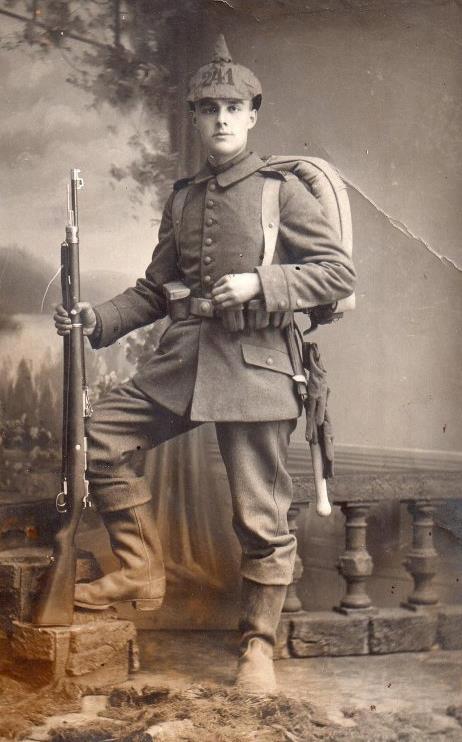

Restored original stahlhelm (a coat of boiled linseed oil gives it that nice period shine) and a pickelhaube with cover

Mauser Gew-98, this is the *only* allowable rifle for IR 75

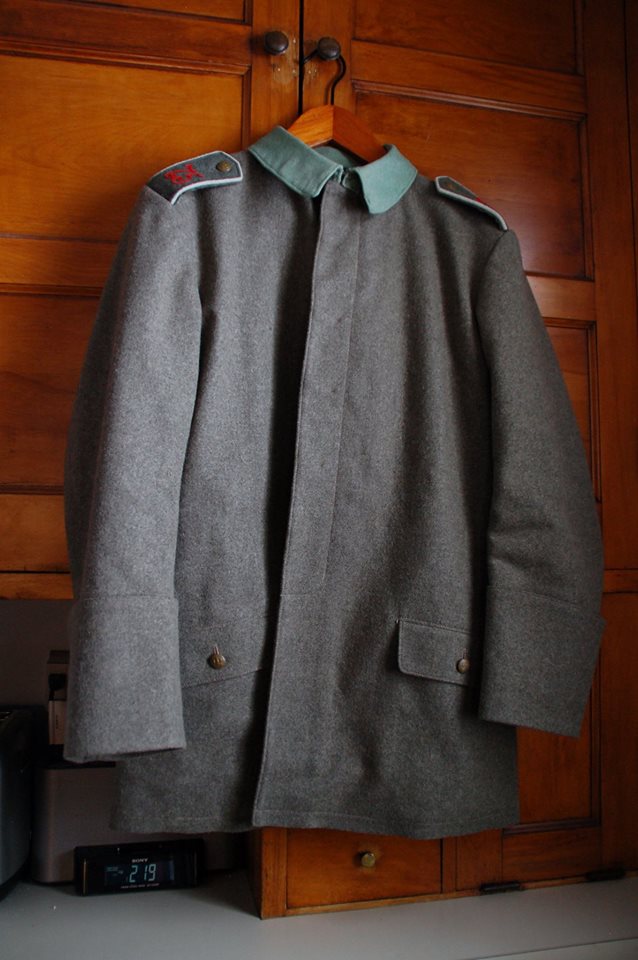
1915 Bluse made by Schuster.ru

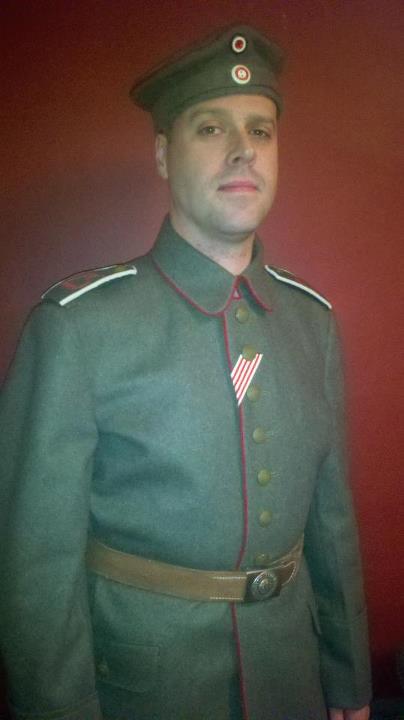
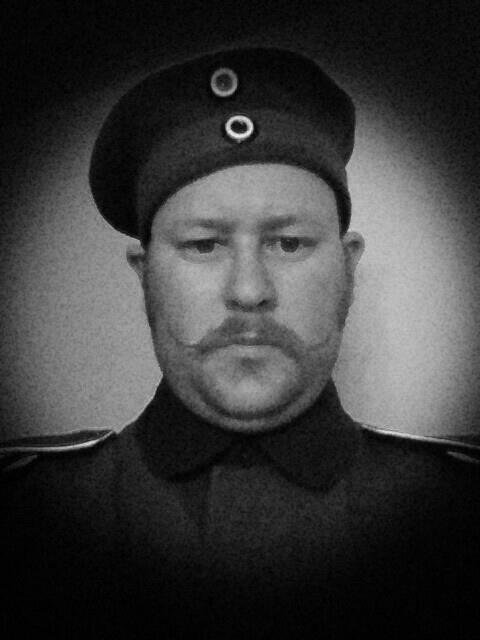
Gefreiter Borum wearing a 1915 Bluse and Feldmutz
Gefreiter Schaaf with a 1914 "transitional" tunic and Hanseatic Cross ribbon
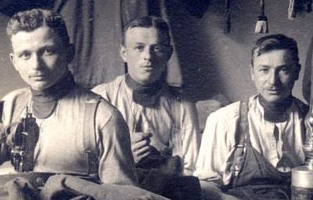
Soldaten wearing neck stocks
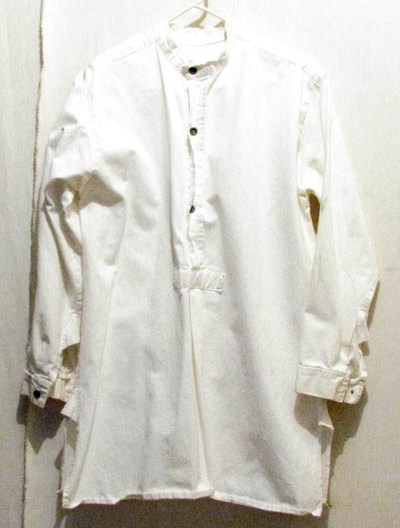
Issue Shirt made of heavy white cotton
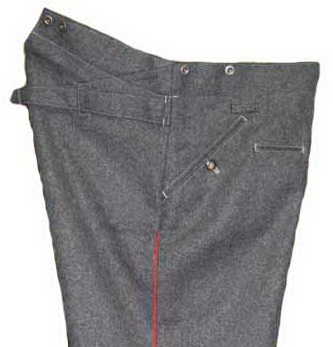
Trousers can be stone grey or field grey wool. They can also be brown, black or grey corduroy. All trousers can be piped in red or left unpiped.
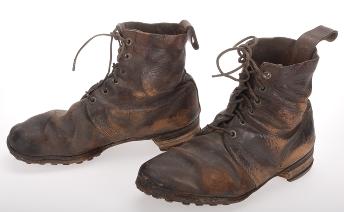
Low quarter boots are worn with puttees, long strips of wool wrapped around the leg to protect the trousers
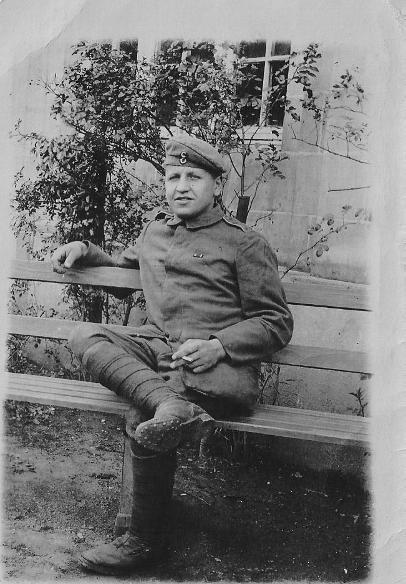
British "ammo" boots from What Price Glory. The use of these are acceptable as captured footwear was often worn later in the war. get the ones without toe caps and make sure you break them well before wearing them at an event.
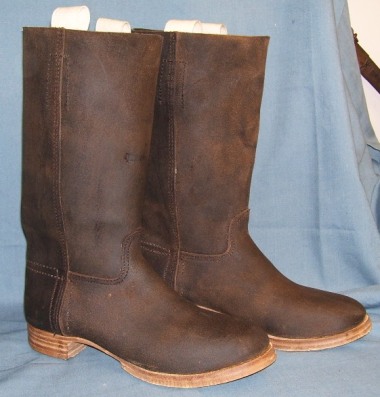
Jack boots are another option for footwear, these can be black or brown but must be of the proper construction.

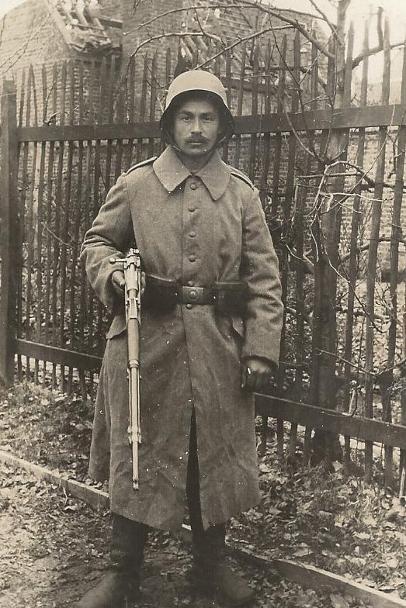
Two original Prussian belt buckles
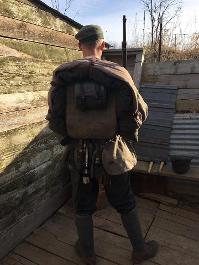
East German shovel (top) and Swiss shovel with carriers, both are acceptable
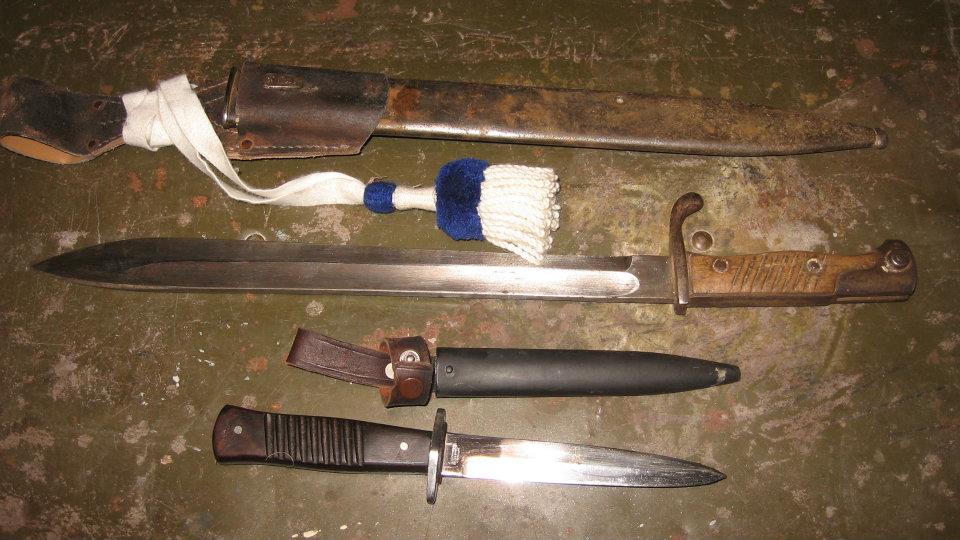
98/05 "butcher" bayonet with 4th company troddel and fighting knife
Original ersatz bayonet with frog and NCO troddel
Reproduction 1907 canteen from Hessen Antique, original ersatz glass canteen
Turkish ammo pouches from Liberty Tree Collectors, these are identical to the German 1909 pouches and more durable than the repro ones
Breadbag from Man The Line
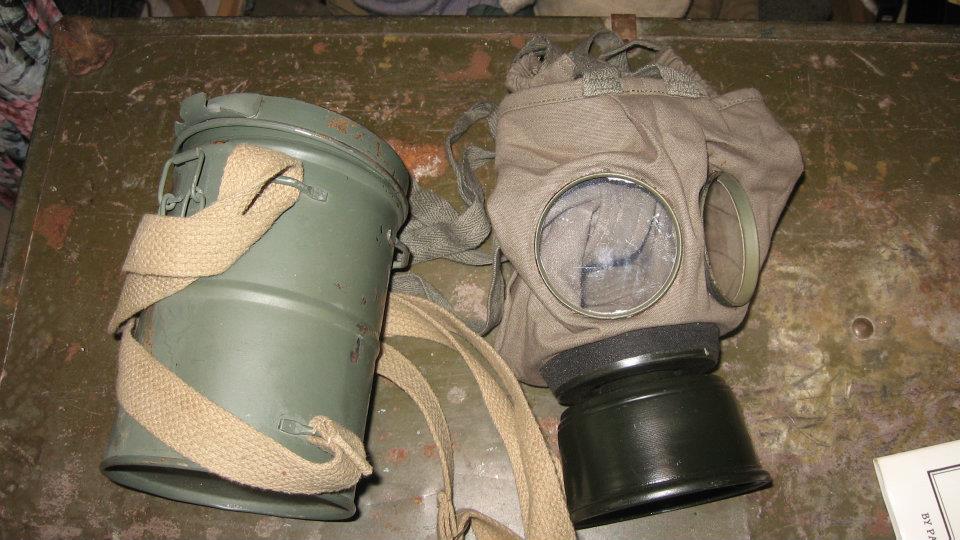
Gasmask and canister from Hessen Antiques
Field dressing, cigarette case, Sterno with a period label (correct for the time), lice powder, matches, matchbook cover
Ration bag, 2 coffee containers with ersatz coffee, toothbrsuh and powder (Dutchie's Militaria), pocket chess/checker set